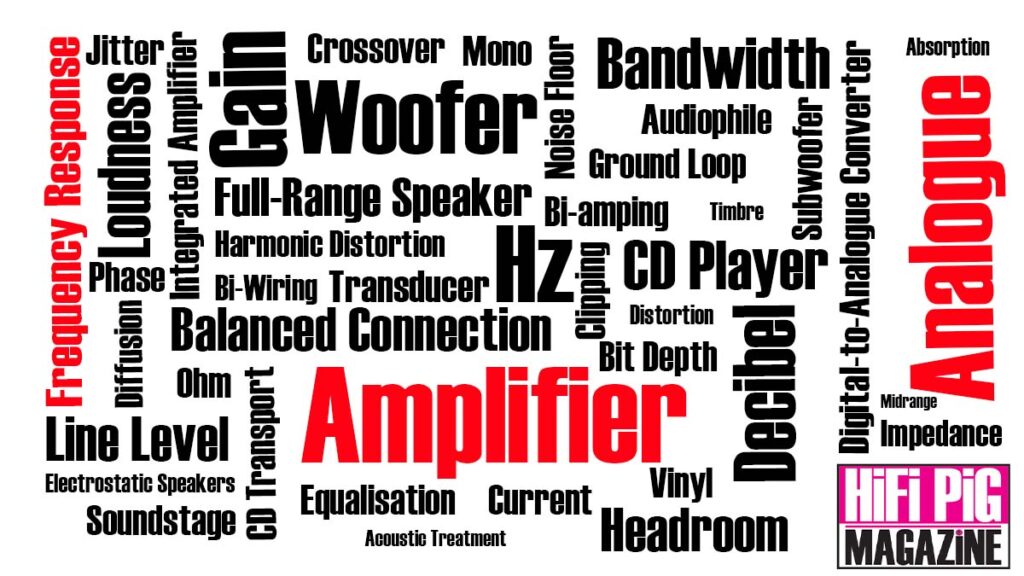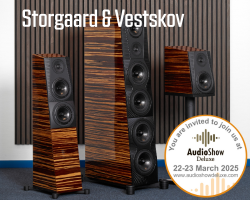A Glossary of HiFi and Home Audio Terms

Below is an in-depth, alphabetised glossary of common HiFi and home audio terms, designed to help enthusiasts and newcomers better understand the concepts that define high-fidelity sound and audio technology.
We’ll add to this over time to make it ever more comprehensive. If you think we need to add something then get in touch here.

A
Absorption
The process by which sound waves are absorbed by a material rather than being reflected. Effective absorption materials help minimise echo and reverberation in a listening space, resulting in clearer audio reproduction.
Acoustic Treatment
Techniques and materials used in a room to manage sound reflections, absorption, and diffusion. These treatments improve sound quality by controlling how sound waves behave within the space. Specialist panels are available to treat your room but many suggest that the “stuff of life” will be sufficient.
Amplifier (Amp)
A device that increases the power of an audio signal to drive speakers and produce sound at a higher volume. Amplifiers come in various types, such as integrated, power, and preamplifiers.
Analogue
A continuous signal that represents audio in its natural form. Analogue systems use waveforms that are smoother and considered more ‘organic’ than digital signals, often associated with vinyl records and tape formats.
Audiophile
Curmudgeonly old duffer with an unhealthy obsession for all things audio – but enough about our editor. An individual with a deep passion for high-quality sound reproduction, often investing in premium audio equipment and dedicating significant time to the pursuit of superior listening experiences. Audiophiles have a love for the electronics and usually the media. Not to be confused with musicophile.
B
Balanced Connection
An audio connection method that uses three wires: two carrying the signal and one as a ground. This setup helps to reduce noise and interference, making it ideal for professional and high-end audio setups.
Bandwidth
The range of frequencies a device or system can accurately reproduce, typically measured in Hertz (Hz). A wider bandwidth allows for a more complete sound representation.
Bi-amping: Using two separate amplifiers to drive different frequency ranges of a speaker independently. In a bi-amped setup, one amplifier typically powers the low-frequency drivers (woofers) while the other drives the high-frequency drivers (tweeters). Bi-amping requires speakers with dedicated inputs for different frequency bands.
Bi-Wiring
A speaker connection method using separate cables for the high and low-frequency drivers. This can reduce interference between the frequencies, potentially improving sound clarity.
Bit Depth
In digital audio, bit depth determines the dynamic range of the sound. For example, a 16-bit depth offers a maximum dynamic range of 96 dB, while 24-bit depth can provide up to 144 dB.
C
Cable Wars
A favourite pastime of audiophile folk whereby the merits or otherwise of (predominantly) expensive audio cables are discussed. The definitive article on Cable Wars can be seen here.
CD Player
A device that reads audio data from Compact Discs (CDs) using a laser to tread and a DAC to convert digital information into an analogue audio signal.
CD Transport
The same as a CD player but without the digital-to-analogue conversion section. A CD transport will require the use of an external DAC.
Clipping
A form of audio distortion that occurs when an amplifier is pushed beyond its power capacity, resulting in a ‘cut-off’ of the sound waveform. This can damage speakers and degrade sound quality.
Crossover
A circuit that splits an audio signal into different frequency bands and directs each band to the appropriate speaker driver (e.g., woofers for bass, tweeters for treble).
Current
In audio systems, current refers to the flow of electric charge. Amplifiers with higher current output can better control speaker drivers, which is particularly important for bass response and complex musical passages.
D
DAC (Digital-to-Analogue Converter)
A device that converts digital audio data into an analogue signal that can be played through speakers or headphones. High-quality DACs are crucial for accurate audio reproduction from digital sources.
Decibel (dB)
A unit used to measure sound level or signal strength. In audio, decibels are often used to express volume levels, with 0 dB typically representing the threshold of human hearing.
Diffusion
The process of scattering sound waves to create a more balanced listening environment. Diffusion prevents direct reflections and helps maintain natural sound.
Distortion
Any alteration of the original sound signal that degrades audio quality. Distortion can occur due to various reasons, including limitations in amplifier power or speaker performance.
E
Equalisation (EQ)
The adjustment of specific frequency bands to alter the overall sound profile. EQ can be used to boost bass, reduce treble, or fine-tune audio for personal preferences.
Electrostatic Speakers
A type of loudspeaker that uses a thin, electrically charged diaphragm placed between two conductive plates. These speakers offer exceptional clarity and detail, particularly in the mid and high frequencies.
F
Frequency Response
The range of frequencies a device can reproduce, often represented as a graph. A flat frequency response indicates that the device reproduces all frequencies equally without bias.
Full-Range Speaker
A type of speaker designed to reproduce the entire range of audio frequencies, from bass to treble. Full-range speakers often sacrifice some precision at the extremes to achieve broad coverage.
G
Gain
A measure of amplification applied to an audio signal, often adjusted to set the input level of an amplifier or recording device. Incorrect gain settings can lead to distortion or reduced sound quality.
Ground Loop
An unwanted current that flows through the ground path, causing a hum or noise in audio equipment. Ground loops are common when multiple devices are connected to different power sources.
H
Headroom
The buffer between the highest signal level and the maximum level that an audio system can handle without distortion. More headroom allows for cleaner sound during dynamic peaks.
Harmonic Distortion
A type of distortion that introduces extra frequencies to the original sound, usually at multiples of the original frequencies. Measured as Total Harmonic Distortion (THD), lower percentages indicate higher audio fidelity.
Hz (Hertz)
The unit of frequency, indicating how many sound waves pass a point per second. Human hearing typically ranges from 20 Hz to 20,000 Hz (20 kHz).
I
Impedance
The resistance of a speaker or audio device to the electrical current supplied by an amplifier, measured in ohms (Ω). Matching impedance between components is essential for optimal performance and avoiding potential damage.
Integrated Amplifier
A single device that combines a preamplifier and power amplifier, simplifying audio system setups by eliminating the need for separate components.
J
Jitter
In digital audio, jitter refers to timing errors during data transmission, which can affect sound quality. High-quality DACs and cables help minimise jitter for a clearer signal.
K
L
Loudness
The perceived strength of a sound, often influenced by both the actual volume level and how human hearing responds to different frequencies.
Line Level
The standard voltage level of an audio signal sent between audio components, such as from a CD player to an amplifier. Line-level signals are stronger than microphone levels but weaker than speaker levels.
M
Midrange
The frequency band that lies between bass and treble, typically between 250 Hz and 4 kHz. This range includes the core frequencies for most musical instruments and human vocals.
Mono (Monophonic)
Audio that is produced through a single channel. Unlike stereo, mono sound lacks the depth and spatial characteristics of multi-channel audio.
Musicophile
Someone who loves music. Not to be confused with audiophile.
N
Noise Floor
The background noise level present in an audio system. A lower noise floor indicates better system quality, allowing more subtle audio details to be heard clearly.
Nominal Impedance
The general impedance value specified for speakers or headphones. Although impedance varies across frequencies, the nominal value gives a rough indication for system matching.
O
Optical Cable
A type of cable that transmits audio signals using light, commonly used for digital audio connections. Optical cables help minimise electromagnetic interference.
Ohm
The unit of measurement for impedance in an audio circuit. Lower-ohm speakers require more current, so amplifiers need to be compatible with the speaker’s impedance rating.
P
Phase
The alignment of sound waves in relation to each other. Phase issues can lead to cancellations or reinforcements of certain frequencies, affecting sound clarity and imaging.
Phono Stage/Preamp
A component that amplifies the signal from a turntable to line level, compensating for the RIAA equalisation applied to vinyl records during recording.
R
Reel-to-Reel Tape
Reel-to-reel tape is an analogue audio recording format that uses magnetic tape wound between two open reels. Popular from the 1940s to the 1980s, it’s renowned for its warm, detailed sound and was a staple in professional studios and audiophile setups. Although largely replaced by digital formats, reel-to-reel has seen a resurgence among enthusiasts for its superior analogue audio quality.
RMS (Root Mean Square)
A method of measuring the continuous power output of an amplifier or the power-handling capacity of a speaker. RMS values give a more realistic understanding of audio power than peak power ratings.
Room Acoustics
The characteristics of a listening space that affect how sound waves interact, including reflections, absorption, and diffusion. Proper room acoustics can dramatically enhance or diminish audio quality.
S
Sensitivity
A measurement of how loud a speaker will play given a certain amount of input power, typically expressed in dB SPL per watt per meter. Higher sensitivity means the speaker requires less power to achieve a given volume.
Soundstage
The perceived three-dimensional space created by a stereo or surround sound system. A well-defined soundstage allows listeners to pinpoint the location of instruments and vocals within a recording.
Subwoofer
A speaker specifically designed to reproduce low-frequency sounds, typically below 100 Hz, enhancing bass response in an audio system.
T
Timbre
The unique quality or colour of a sound that distinguishes it from others, even if they share the same pitch and volume. Timbre helps differentiate between instruments playing the same note.
Total Harmonic Distortion (THD)
A measurement of distortion within an audio system, expressed as a percentage. Lower THD values indicate a cleaner, more accurate sound.
Transducer
A device that converts one form of energy into another, such as a speaker driver converting electrical signals into sound waves.
V
Vinyl
An analogue format for music playback that uses a grooved disc. Vinyl records are prized for their warm sound profile and natural dynamic range.
Voltage
The electrical potential difference that drives current through a circuit. In audio systems, proper voltage management ensures signal integrity and optimal component performance.
W
Watt
A unit of power used to measure the output capability of an amplifier or the power-handling capacity of speakers. More watts allow for higher sound levels and better dynamic range.
Woofer
The part of a loudspeaker designed to reproduce low-frequency sounds, typically below 500 Hz.
X
Y
Z
Zero Feedback
An amplifier design where no part of the output signal is fed back into the input stage. This design aims to produce a more natural sound, though it can be less stable than amplifiers with feedback circuits.
READ MORE ARTICLES IN THE AUDIO COMPANION SERIES OF ARTICLES




















































































































































































